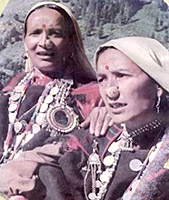 The concentration of these Gaddis tribes is mainly found on both sides of the Dhauladhar Range of the state of Himachal Pradesh. Quite a number of Gaddi tribes also dwell mainly in the Brahmaur region of Chamba District, in the higher regions of the Ravi River and also the valleys of the Budhil River. Other regions include Kangra district, chiefly in the villages of the Tota Rani, Khaniyara, close to Dharamsala.
The concentration of these Gaddis tribes is mainly found on both sides of the Dhauladhar Range of the state of Himachal Pradesh. Quite a number of Gaddi tribes also dwell mainly in the Brahmaur region of Chamba District, in the higher regions of the Ravi River and also the valleys of the Budhil River. Other regions include Kangra district, chiefly in the villages of the Tota Rani, Khaniyara, close to Dharamsala.
As per the records of the anthropologists, the origin of these Gaddi tribes has a rich history behind the development of this tribal community. In fact about their origination, popular myths are quite popular in whole of the state of the Himachal Pradesh. It has been assumed that the Gaddi tribes came down from emigrants who had taken refuge in the plain lands of Indian Territory.
 Another legend is common about the Gaddi community. According to this legend, it is thought that various castes of the Gaddi tribal community have been transmigrated at different times. Around 850-70CE, a group of Brahmin Gaddi tribe moved to Chamba and situated their abode permanently. Majority of the other castes of Gaddi tribal community have descended to the mountain ranges to run away from the threats of the famous Mughal emperor Aurangzeb at the time of seventeenth century CE. Most of he Gaddi tribal people are the worshiper of Lord Shiva.
Another legend is common about the Gaddi community. According to this legend, it is thought that various castes of the Gaddi tribal community have been transmigrated at different times. Around 850-70CE, a group of Brahmin Gaddi tribe moved to Chamba and situated their abode permanently. Majority of the other castes of Gaddi tribal community have descended to the mountain ranges to run away from the threats of the famous Mughal emperor Aurangzeb at the time of seventeenth century CE. Most of he Gaddi tribal people are the worshiper of Lord Shiva.
There are people of several other castes in the whole of the Gaddi tribal society namely Thakur, Khatri, Brahmin, Dhangar, Rajput, and Rana. The people of this tribal community are oriented towards religion as well as spiritualism. Both the religions of Hinduism Gaddi Tribal Customs and also Islam are being practiced by a large section of the Gaddi tribal community.
The distinctness lies not only among the people of Gaddi community but also in their dressing type. The Gaddi men wear chola, turban or safa and dora and women wear launchiri. Gold ornaments especially gold earrings are used by both the men and women of this community.
The Indian anthropologist has duly highlighted another aspect; by nature, these Gaddi tribes are largely esteemed for their honesty, friendly disposition and peaceable life-style. Crime is almost obscure in almost all the villages of the Gaddi tribal community.
 In order to meet the requirements of day to day living, these Gaddi tribes have taken up diverse occupational activities. Since these Gaddi tribes have built their settlements in the villages, they are not considered to be nomads. However, seasonal movement of sheep and goats to higher or lower pasture is a conventional practice. In general, these Gaddi tribes go with their livestock to several pastures of the upper regions of the state at the time of summer season.
In order to meet the requirements of day to day living, these Gaddi tribes have taken up diverse occupational activities. Since these Gaddi tribes have built their settlements in the villages, they are not considered to be nomads. However, seasonal movement of sheep and goats to higher or lower pasture is a conventional practice. In general, these Gaddi tribes go with their livestock to several pastures of the upper regions of the state at the time of summer season.
As far as the languages are concerned, the majority of the Gaddi tribe speaks Gaddi language. For writing, however, this Gaddi tribal community uses Takri language. However, the language had gone into oblivion only few years back. Devangiri script is in vogue. Also under the impact of the modern day culture, the Gaddi tribal people have also mastered Hindi language.
















